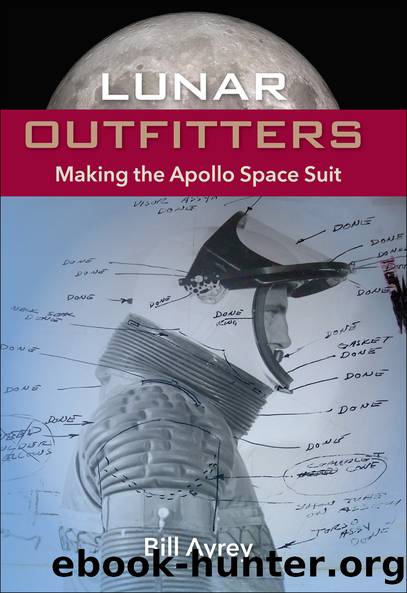Lunar Outfitters by Ayrey Bill;

Author:Ayrey, Bill; [Неизв.]
Language: eng
Format: epub
Publisher: University Press of Florida
Published: 2020-10-25T20:00:00+00:00
While practicing months ahead of their scheduled Apollo 7 launch date, the three astronauts found it difficult to work side by side in the command module seats in their training suits. The problem centered on arm bearings that were too bulky and added to the width of the suit across the upper arms resulting in interference between the three crew members. ILC looked at all the options and following discussions and an agreement with NASA, they decided to remove the arm bearings for the first pre-lunar missions.59 This decision was relatively simple to reach since limited arm mobility was required within the spacecraft and, except for the Apollo 9 mission, the suits would not be pressurized unless there was the unexpected loss of pressure. The plan was that the Apollo 9 crew would conduct the first Apollo-suited EVA while in Earth orbit, but even then, the arm mobility that would be required would be minimal compared to what would be expected for the lunar missions. This gave ILC time to work out the new bearing design in conjunction with an arm redesign that would reduce the size of the cross-section significantly. ILC had approximately ten months to come up with this fix. This is but one example of the challenges that the ILC suit engineers constantly faced.
The solution to the excessive arm width was to remove the arm bearing and replace it with nylon link-net material. This arm configuration was successfully used by all three crew members of the Apollo 7 through the Apollo 10 missions and then by the command module pilots on Apollo 11 through 14.
In addition to removing the bearing, ILC removed some insulation from the TMG layers under the arms of the two extravehicular suits. This area would not see excessive heat loads during an EVA, which was not even planned for the Apollo 7 mission. The insulation would be added back in for the Apollo 8 and subsequent missions, but I recall one of the Apollo veterans telling me that Neil Armstrong requested that some of the insulation be removed under the arms of his suit to provide more comfort in terms of fit and mobility.
Both the commander (Wally Schirra) and the lunar module pilot (Walt Cunningham) wore extravehicular suits, while the command module pilot (Don Eisele) wore the intravehicular suit.
On June 8, 1968, ILC employees Bill Dougherty and Bill Fry very proudly hand-delivered the first Apollo flight suits from the Dover plant to the Kennedy Space Center. They loaded the suits into a small charter plane at the nearby Cheswold, Delaware, airport and taxied down the runway for a short trip to Washington National Airport, where they transferred onto a commercial flight to Florida. The suits almost did not make it however, because shortly after takeoff, Dougherty noticed that a hatch had opened near the cases containing the suits. Fortunately, he was able to quickly close and lock the hatch before the precious cargo became bits of debris scattered across the farm fields of Kent County, Delaware.
Download
This site does not store any files on its server. We only index and link to content provided by other sites. Please contact the content providers to delete copyright contents if any and email us, we'll remove relevant links or contents immediately.
| Aerodynamics | Aircraft Design & Construction |
| Astronautics & Space Flight | Avionics |
| Gas Dynamics | Propulsion Technology |
Whiskies Galore by Ian Buxton(41561)
Introduction to Aircraft Design (Cambridge Aerospace Series) by John P. Fielding(32906)
Small Unmanned Fixed-wing Aircraft Design by Andrew J. Keane Andras Sobester James P. Scanlan & András Sóbester & James P. Scanlan(32589)
Craft Beer for the Homebrewer by Michael Agnew(17953)
Turbulence by E. J. Noyes(7733)
The Complete Stick Figure Physics Tutorials by Allen Sarah(7162)
Kaplan MCAT General Chemistry Review by Kaplan(6629)
The Thirst by Nesbo Jo(6473)
Bad Blood by John Carreyrou(6295)
Modelling of Convective Heat and Mass Transfer in Rotating Flows by Igor V. Shevchuk(6244)
Learning SQL by Alan Beaulieu(6056)
Weapons of Math Destruction by Cathy O'Neil(5873)
Man-made Catastrophes and Risk Information Concealment by Dmitry Chernov & Didier Sornette(5687)
Digital Minimalism by Cal Newport;(5416)
Life 3.0: Being Human in the Age of Artificial Intelligence by Tegmark Max(5211)
iGen by Jean M. Twenge(5187)
Secrets of Antigravity Propulsion: Tesla, UFOs, and Classified Aerospace Technology by Ph.D. Paul A. Laviolette(5071)
Design of Trajectory Optimization Approach for Space Maneuver Vehicle Skip Entry Problems by Runqi Chai & Al Savvaris & Antonios Tsourdos & Senchun Chai(4859)
Electronic Devices & Circuits by Jacob Millman & Christos C. Halkias(4767)
